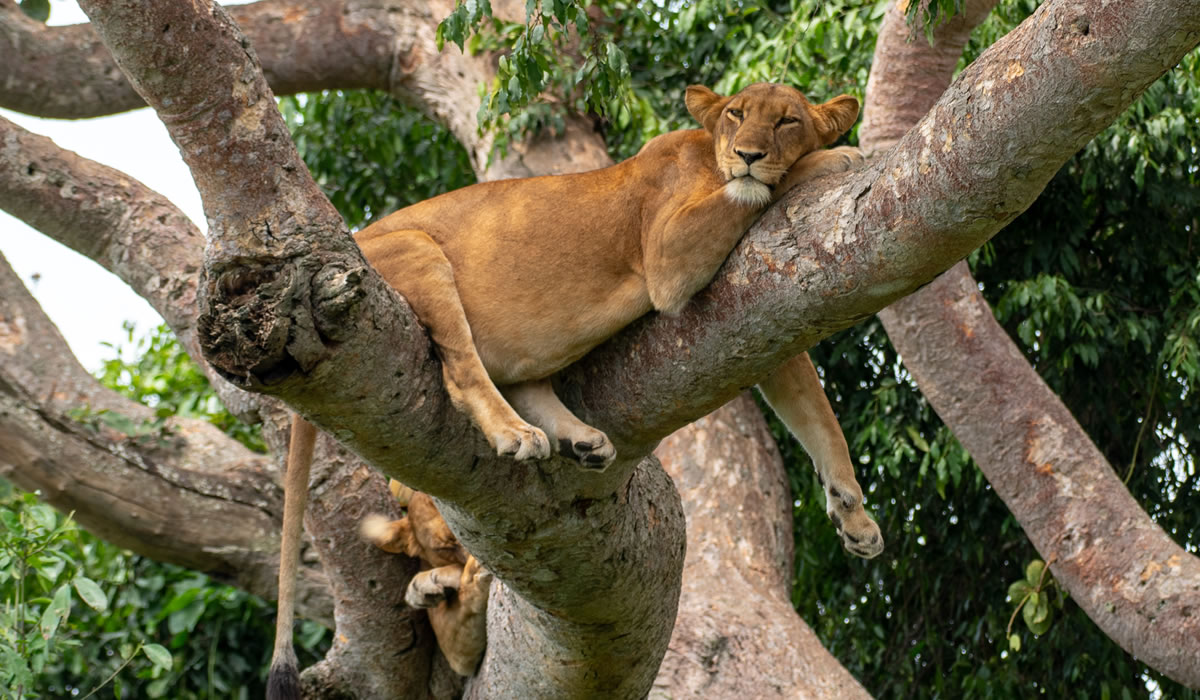Queen Elizabeth National Park is one of Uganda’s most celebrated natural wonders and a crown jewel in the country’s extensive network of protected areas. Located in the western region of Uganda, straddling the districts of Kasese, Kamwenge, Rubirizi, and Rukungiri, the park covers approximately 1,978 square kilometers. It is Uganda’s most popular savannah park and the second-largest in the country after Murchison Falls National Park. Named in honor of Queen Elizabeth II following her visit in 1954, the park boasts a unique blend of landscapes, ecosystems, and biodiversity, making it a must-visit for nature lovers, wildlife enthusiasts, and adventure seekers.
Queen Elizabeth National Park is distinguished by its astonishing ecological diversity. Its landscapes range from vast open savannahs, humid tropical forests, sparkling lakes, and fertile wetlands to the dramatic craters of the western arm of the Great East African Rift Valley. The park stretches from Lake George in the northeast to Lake Edward in the southwest, with the Kazinga Channel linking the two lakes and acting as a central feature of the park.
This rich tapestry of habitats supports an equally diverse range of wildlife, including more than 95 species of mammals and over 600 species of birds, making it one of the most biodiverse parks in Africa.

Activities in Queen Elizabeth National Park
1. Game Drives
Game drives are among the most popular activities in the park, offering a classic safari experience across the expansive savannah plains. The Kasenyi Plains in the northeastern section are particularly rich in wildlife and provide the best opportunities to spot iconic African animals such as lions, elephants, buffaloes, Ugandan kob, waterbucks, warthogs, and sometimes leopards. Early morning and late afternoon are the best times for game drives, as wildlife is most active during these hours.
The Mweya Peninsula also offers rewarding game drives with chances to see predators and herbivores against the stunning backdrop of Lake Edward and the Rwenzori Mountains.
2. Boat Safari on the Kazinga Channel
A highlight of any visit to Queen Elizabeth National Park is the boat safari along the Kazinga Channel, a natural waterway that connects Lake George to Lake Edward. The two-hour cruise offers incredible opportunities to see large concentrations of hippos, crocodiles, and buffaloes cooling off along the shoreline, along with elephants coming to drink. The boat ride also provides exceptional birdwatching, with frequent sightings of African fish eagles, kingfishers, great white pelicans, saddle-billed storks, and pink-backed pelicans.
The Kazinga Channel is considered one of the best wildlife-viewing spots in Uganda due to the sheer abundance and density of animals along its banks.
3. Chimpanzee Tracking in Kyambura Gorge
For a contrast to the open savannah, the Kyambura Gorge also known as the “Valley of Apes” offers a lush, forested chasm teeming with life. It is home to a small but habituated group of chimpanzees, as well as other primates like black-and-white colobus monkeys, vervet monkeys, and baboons. Chimpanzee tracking in Kyambura is more challenging due to the terrain and smaller chimp population, but it offers a rewarding and intimate experience in a unique setting.
4. Bird Watching
Queen Elizabeth National Park is a birder’s paradise. With over 600 bird species, it ranks as one of the top birding destinations in the world. Key birding areas include the Kazinga Channel, Maramagambo Forest, Ishasha Sector, and Lake Katwe. Notable species include the African skimmer, shoebill stork, martial eagle, papyrus gonolek, flamingos (especially at the salt lakes), and numerous waterfowl and raptors.
The park’s diversity of habitats ensures a wide range of avian life—from forest dwellers to aquatic birds and savannah species.
5. Exploring the Crater Lakes
The park is dotted with several volcanic crater lakes, particularly in the north near Katwe and Bunyaruguru. These ancient craters now host scenic lakes, some of which are saline and support unique vegetation and birdlife. The Katwe Salt Lake is historically significant for its centuries-old salt mining practices, which continue to this day. Visitors can observe the traditional process of salt harvesting and engage with local miners.
6. Ishasha Sector: Home of the Tree-Climbing Lions
The Ishasha Sector, located in the southern part of the park, is famous for its rare and intriguing tree-climbing lions. Unlike most lions, the prides here often rest in the branches of large fig and acacia trees, especially during the heat of the day. This behavior, though not fully understood, is thought to help avoid biting insects and take advantage of cool breezes. Spotting these majestic cats perched in trees is a unique and thrilling experience, adding an extra layer of excitement to the safari.
Things to See in Queen Elizabeth National Park
- Mammals: Including elephants, buffaloes, lions, leopards, hyenas, Uganda kob, hippos, and bushbucks.
- Primates: Chimpanzees in Kyambura Gorge, olive baboons, black-and-white colobus monkeys, and vervet monkeys.
- Birds: Shoebill, African fish eagle, malachite kingfisher, pink-backed pelican, and many more.
- Kazinga Channel: A central wildlife hotspot, perfect for boat safaris and birding.
- Katwe Salt Lake: A cultural site offering insights into traditional salt extraction.
- Crater Lakes: Scenic spots for photography, hiking, and nature walks.
- Maramagambo Forest: Offers forest hikes and chances to see bats, forest birds, and primates.
- Lake Edward and Lake George: Important water bodies supporting aquatic life and migratory birds.
Best Time to Visit
Queen Elizabeth National Park is open year-round, but the experience can vary significantly depending on the season.
Dry Seasons (June to August and December to February)
These are the best months to visit the park, especially for game viewing. The grass is shorter and animals tend to congregate around water sources, making them easier to spot. Roads and trails are also more accessible during the dry season.
Wet Seasons (March to May and September to November)
During the rainy months, the park becomes lush and green, making for excellent photography. Birding is particularly rewarding during this time, as migratory birds arrive and resident species enter their breeding plumage. However, some roads may become slippery, and wildlife viewing can be more challenging due to dense vegetation.
Where to Stay
Queen Elizabeth National Park offers a variety of accommodation options, catering to luxury travelers, mid-range budgets, and budget-conscious backpackers.
Luxury Lodges
- Mweya Safari Lodge: Located on the Mweya Peninsula, offering panoramic views of the Kazinga Channel and luxurious amenities including a pool and spa.
- Kyambura Gorge Lodge: A stylish eco-lodge near the Kyambura Gorge, known for its excellent service and design.
- Ishasha Wilderness Camp: An upscale tented camp in the Ishasha Sector, ideal for exploring the area’s tree-climbing lions.
Mid-Range Lodges
- Enganzi Game Lodge: Located on the escarpment with beautiful views and comfortable accommodations.
- Bush Lodge: Offers great value with en-suite tents and bandas near the Kazinga Channel.
- Elephant Plains Lodge: A mid-range option offering a mix of comfort, good food, and beautiful views over the plains.
Budget Options
- Simba Safari Camp: Offers affordable accommodation near the park entrance at Katunguru.
- The Baboon Safari Resort: Budget-friendly and conveniently located, with basic amenities and a restaurant.
How to Get There
By Road
From Kampala, the capital city of Uganda, Queen Elizabeth National Park is approximately 410 kilometers away. The drive takes about 6–7 hours, depending on the route taken. The most common route is via Masaka–Mbarara–Bushenyi, entering the park near the Mweya Peninsula or Katunguru Gate.
The park is also accessible from Fort Portal, about 2–3 hours away, making it a convenient addition to a trip that includes Kibale Forest National Park.
If coming from Bwindi Impenetrable National Park, particularly from the Buhoma sector, the Ishasha gate of Queen Elizabeth National Park is just a few hours’ drive, making it an excellent stopover on a longer western Uganda safari circuit.
By Air
Chartered flights can be arranged from Entebbe International Airport to airstrips within or near the park, such as the Mweya Airstrip or Kasese Airstrip. Flying saves considerable travel time and offers stunning aerial views of the park and its surroundings.
Conservation and Community Involvement
Queen Elizabeth National Park is not just a protected area for wildlife; it’s also a place where conservation and community coexist. Numerous conservation initiatives operate in and around the park to combat human-wildlife conflict, promote environmental education, and support sustainable tourism.
Community-based tourism ventures, such as the Katwe Salt Lake Tour and Kikorongo Women’s Community, give visitors the chance to interact with local people, learn about their traditions, and directly contribute to their livelihoods. These partnerships are vital for ensuring that local communities see tangible benefits from conservation efforts and remain invested in the park’s long-term protection.
Queen Elizabeth National Park embodies the essence of Uganda’s natural beauty and ecological richness. From the roaring lions of the Ishasha plains to the tranquility of the Kazinga Channel, and from chimpanzee calls echoing through Kyambura Gorge to the mesmerizing songs of birds in the crater lakes, every moment in the park is one of discovery and awe. Whether you’re on your first safari or a seasoned traveler returning to East Africa, Queen Elizabeth National Park promises an unforgettable experience, a harmony of wildlife, wilderness, and wonder.

